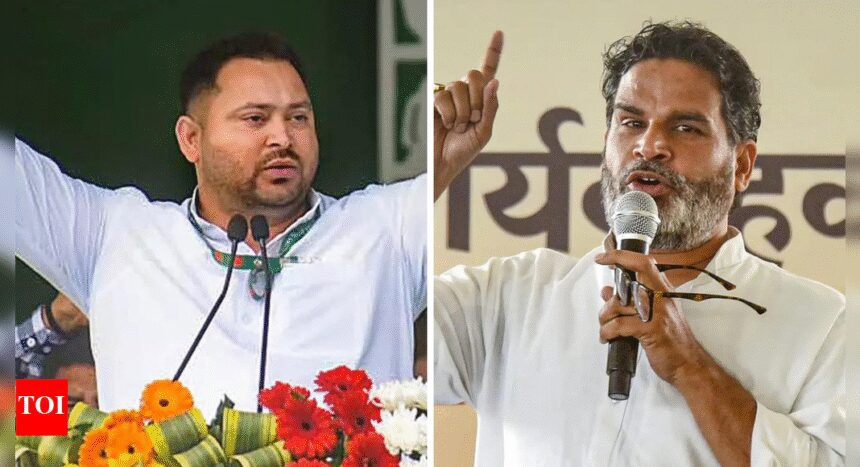NEW DELHI: Bihar’s political landscape has been shaped by the enduring influence of RJD patriarch Lalu Yadav and Janata Dal (United) chief Nitish Kumar for over three decades. As both leaders approach the end of their political careers, the upcoming assembly elections may usher in a period of uncertainty, potentially allowing a new contender to rise to prominence.
In Vaishali’s Raghopur constituency, the clash of fresh political figures is anticipated, with RJD’s Tejashwi Yadav and Jan Suraaj chief Prashant Kishor possibly emerging as candidates. This seat has been a stronghold for the Lalu family; Lalu Yadav himself won here in 1995 and 2000, while his wife Rabri Devi secured victories in 2000 and 2005. However, she lost to JD(U)’s Satish Kumar Yadav in 2010 during Nitish Kumar’s “Sushashan” wave. Since 2015, Tejashwi has successfully held this seat.
In the upcoming election, Tejashwi is likely to contest again from RJD’s traditional stronghold. Nonetheless, there are speculations regarding a potential run from Mithilanchal’s Phulparas seat as suggested by party leadership. This move may not only aim to solidify RJD’s traditional Muslim-Yadav voter base but also seek to broaden its appeal among the Extremely Backward Classes (EBC), who make up approximately 36% of Bihar’s population and have largely aligned with the NDA thus far.
According to RJD leaders, a candidacy from Phulparas could send a substantial message to the EBC community, enhancing the party’s prospects in that region. “Our socialist icon Karpoori Thakur also represented this seat in the past, and hence Tejashwi was advised to consider the suggestion. Ultimately, it is his decision,” an RJD leader stated.
Tejashwi’s interest in another seat may also reflect a strategic response to Prashant Kishor’s hints about contesting against him from Raghopur should his party nominate him. Kishor has claimed that Tejashwi would face a tough challenge if Jan Suraaj fields him in Raghopur, suggesting that the situation could parallel Congress leader Rahul Gandhi’s previous defeat in the Amethi Lok Sabha constituency in Uttar Pradesh six years ago.
“We will reach Raghopur to engage with comrades and workers who are spreading the message of Jan Suraaj against the RJD’s dominance; we will solicit the public’s views for inclusion in our Central Committee’s deliberations,” Kishor said. Earlier, he indicated that if he were to enter electoral politics, it would be exclusively to contest against Tejashwi.
The speculation surrounding Prashant Kishor’s candidacy from Raghopur and Tejashwi’s potential run from another constituency remains uncertain. However, such conjectures may not be a reliable measure of forthcoming electoral dynamics.
Why is Raghopur significant for the Lalu family? The Raghopur assembly seat in Bihar’s Hajipur district is primarily influenced by the Yadav caste, a critical voter base for the Rashtriya Janata Dal. Lalu Yadav, representing Janata Dal, won this seat in 1995 and again in 2000, before vacating it for Rabri Devi, who won subsequent bypolls. She maintained the seat in 2005 but lost to JD(U)’s Satish Kumar Yadav in 2010. In 2015, Tejashwi Yadav successfully launched his political career from Raghopur and retained the seat in 2020, defeating BJP’s Satish Kumar Yadav by a margin of 38,000 votes.
The Election Commission has finalized the schedule for the Bihar assembly elections. Voting for all 243 assembly seats will occur in two phases on November 6 and November 11, with the counting of votes set for November 14. The total electorate stands at 7.42 crore. As of June 24, there were 7.89 crore electors, indicating that 65 lakh voters were removed from the draft list, which now totals 7.24 crore.
In the 2020 assembly elections, the BJP contested 110 seats and won 74, capturing 19.8% of the vote share. The Janata Dal (United) contested 115 seats, winning 43 with a 15.7% vote share, while the Hindustani Awam Morcha (Secular) contested seven seats, securing four, with a vote share of 0.9%.










